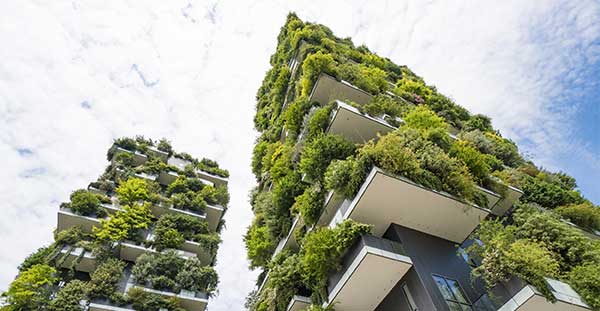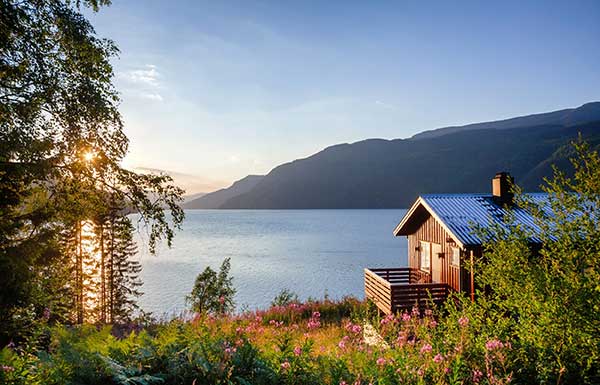Sustainable buildings go by many names: green buildings, green construction, and energy-efficient buildings, to name just a few. Whatever moniker you use, a sustainable building’s overarching goal is the same: to protect the planet, people, and pocketbook (or profit) through sustainable methods. In short, a sustainable building aims to have as minimal an environmental impact as possible.
In this guide, you’ll learn how developers, architects, and engineers are reimagining building techniques with sustainable buildings. You’ll also discover how reducing the environmental impact of buildings can help tackle climate change and lower harmful greenhouse gas emissions that impact all of us.
Why Do We Need Sustainable Buildings?
Buildings and the building construction sector combined consume more than one-third of all the world’s energy demands and are responsible for almost 40% of the planet’s direct and indirect carbon dioxide (CO2) emissions. Energy-related CO2 emissions from buildings have risen 5% from 2010 to 2019, and buildings were responsible for 28% of global energy-related CO2 emissions in 2019.
Between the years 2000 and 2019, global energy demand increased by almost 48%. In 2019, renewable energy provided only 14.5% of energy demand while oil provided 33.1% of our energy needs, the largest sector among fossil fuels’ enormous 84.3% contribution to energy provision.
These demands drive climate change and bring warmer temperatures, creating a vicious circle of extra energy demand for heating and air conditioning in our already energy-hungry buildings.
What Is a Sustainable Building?
There are no specific, regulated measures for what construes a sustainable building or sustainable architecture, but there are industry-respected accreditations and certificates to guide people. What is clear is that the construction industry must meet the 21st-century’s need for sustainability.
Sustainable or green buildings reduce their environmental impact and effect on human health through:
- Efficient use of energy, water, and other resources.
- Protecting the building dweller’s health and, in commercial buildings, the worker’s productivity.
- Reducing waste and pollution.
- Preventing environmental damage and loss, including citing considerations.
Ways to achieve this include fewer new buildings (e.g., keeping any new construction as small as possible), avoiding urban sprawl, and refitting existing buildings where possible.
Architects look at recycling wastewater, environmental and indoor air quality, and the building’s structural, operational, and maintenance efficiency. They also consider how green buildings harmonize with their surroundings, where materials come from, and generating onsite renewable energy.
What Are Some Features of a Sustainable Building?
Sustainable buildings usually implement many of the same ideas that are then tailored to their ecosystem and landscape. A sustainable mountain house in the north of Norway has different sustainability requirements than a sustainable coastal home in Florida.
Architects take into account the building’s placement, orientation, and function when considering the following green building features:
Renewables: Solar panels, solar water heating, wind turbines, small hydropower schemes, and air or ground heat pumps reduce a building’s reliance on fossil fuel-produced energy. Some installations can use localized geothermal energy to heat water and buildings.
Natural light: Double-glazed windows allow homes to warm up via natural sunlight, and designs can incorporate as much natural light as possible, reducing energy use. Awnings, blinds, and shutters can keep the sun out in warmer climates, keeping the building cooler.
Low impact building materials: Alternatives to concrete or asphalt can lower the building’s carbon footprint and be more environmentally friendly to watercourses.
Water: Recycling and reuse of greywater onsite and composting toilets can reduce water usage.
Insulation: Window placement can help with natural ventilation, and a well-ventilated house is key to energy conservation.
Landscaping: There are many imaginative uses of the local landscape that can help cool or warm buildings. For example, deciduous trees block the summer sun to keep buildings cool, then let sunshine in during winter months to warm them. Similarly, pine trees can protect homes from cold winds, and buildings close to bodies of water can keep homes cool.
Size: Keeping homes as compact as possible reduces energy use compared to large, sprawling buildings.
These are some of the ways sustainable buildings make the most of their surroundings and materials — let’s have a more detailed look.
The 6 Fundamental Principles of Sustainable Building Design
There are six fundamental principles in sustainable design that underpin the three Ps — people, planet, and profit/pocketbook. These elements help create the win-win-win aspect of well-implemented green buildings. The International Telecommunication Union (ITU), the specialized agency of the United Nations for information and communication technologies, offers the following guidelines for sustainable building.
1. Optimal Size Potential
A sustainable building starts with proper site selection and includes looking at the reuse or reformation of existing buildings. Consideration about location, orientation, and how the structure affects local ecosystems is vital — wildlife, soil composition, watercourses, and even airborne particles are just a few factors.
New homes are best built in already urbanized areas. Building in green or wilderness regions can encourage sprawl and have a large carbon footprint due to taking materials to remote areas, possible road building, and further infrastructure creation. Architects should take care to support native fauna and flora, regulate storm-water systems, and take into account the effects of light pollution.
A sustainable building also needs to blend in with its natural and possibly historic area. If building a larger campus, electric cars, bicycles, and public transport should take precedence over fossil fuel-based transport modes.
2. Water Efficiency
Freshwater is an increasingly scarce resource, so a building should be as water-efficient as possible. Sustainable construction should reuse and recycle onsite water as much as possible, and integrate water-efficient landscaping. It should also implement eco-friendly wastewater management technologies, such as greywater for showers, flushing toilets, and washing. If a new, remote home doesn’t have a fresh water supply, the carbon footprint for pumping water to it will be very high, and taking water from a local stream or brook has knock-on effects for wildlife.
3. Optimize Energy Use
Sustainable development should reduce overall energy use to lower operating costs as we continue on the road to net-zero energy in buildings. This includes everything from onsite renewable energy production to ensuring all appliances are energy efficient. Energy Star is an excellent starting point for energy efficiency tips. It’s important to note that some natural materials have higher total emissions than manufactured options, albeit it’s a complex calculation.
In the U.S., more than half the energy used in a home is on heating and air conditioning; careful attention to water heating, ventilation, and insulation can help sustainable buildings lower their greenhouse gas emissions.
4. Materials and Resources
In 1950, the world population was an estimated 2.6 billion. By 2050, the U.N. anticipates it will be almost four times that, at 9.7 billion. Natural resource consumption will increase and put pressure on supplies. The construction industry is an energy-intensive one, from material extraction to manufacture, transport, and building.
A sustainable building should use and reuse materials as productively and sustainably as possible throughout its lifetime. Materials should not deplete resources, create negative environmental impacts, or use virgin materials. Developers should choose recycled options where appropriate, ideally from local, certified, sustainable sources to lower the building’s carbon footprint. Reusing materials also means less construction waste for landfill sites.
5. Enhance Indoor Environmental Quality (IEQ)
The indoor environmental quality (IEQ) of a building focuses on enhancing the well-being of its occupants. To use an analogy, there are many cacti in Texas, but they wouldn’t make great sofas. So even if IEQ were to consider cacti an abundant local material, it doesn’t really matter if its use isn’t apt or beneficial.
The IEQ’s remit is to ensure construction materials — sealants, paints, insulation, adhesives, etc. — do not emit toxins, which are known as volatile organic compounds (VOC). Low-emitting compounds do not harm the dweller’s health and comfort.
IEQ stretches to providing adequate ventilation, optimizing the use of natural light (daylighting), acoustics, and easy or smart lighting and heating systems.
Enter your ZIP Code and compare electricity rates
6. Maintenance and Operation
A life cycle assessment (LCA) ensures that good design coupled with well-chosen materials will create greater energy conservation during a building’s lifetime.
Picking the best site for a building, selecting materials that require less water and less maintenance all help reduce the building’s running costs and environmental impact over its lifetime. The ability for off-site recycling is essential, too.
Another consideration is the building envelope: the roof, exterior walls, subfloor, exterior doors, and windows of a building. There are two types — loose and tight.
Loose building envelopes tend to allow air to flow more freely through the building while tight controls restrict airflow. Choosing the correct building envelope for the location can make maintenance easier and lower energy use significantly. For example, it can keep houses cooler in warmer climes through adequate ventilation.
What Types of Materials Are Used in Sustainable Buildings?
There are a wide variety of sustainable materials used in green and sustainable buildings.
Insulation could be recycled cork (Thermacork), straw bales, sheep wool, recycled denim, or cellulose (recycled newsprint and paper). Hemp, soya, and many more natural insulation options also exist.
For the structure, timber is sourced from sustainably-harvested forests. Bamboo is increasingly popular thanks to its fast growth and great strength despite its lightweight frame. Hong Kong constructors still use bamboo scaffolding when building skyscrapers.
Other low-impact building materials include using packed gravel or permeable concrete instead of conventional concrete. Bark from trees that used to be burned now makes bark siding or cladding and can last many decades.
Rammed earth walls are made from a mix of gravel, sand, and other aggregates, making durable floors, walls, and foundations, as seen in parts of the Great Wall of China. They make great thermal storage, warming in the day and releasing heat at night. Some building sites are situated where required material exists, so builders can use local and earth and stone for the project.
Structural insulated panels (SIPs) are two boards that sandwich insulating foam, offering energy-efficient, insulated, prefabricated walls that can be made to almost any design. While not instantly sustainable in aspect, they offer a low carbon footprint per square foot of build.
On the roof, Tesla offers solar roof tiles instead of solar panels, ideal for urban buildings. Green roofs — a layer of vegetation growing on a roof — can improve insulation, reduce pollution, save energy, and improve life quality.
As mentioned, some paints do not use volatile organic compounds (VOC), reducing the toxins in a building’s interior.
High-performance smart glass helps regulate a building’s temperature. When it’s warm, the windows become translucent and block certain rays of the sun to help keep the place cool; in winter, they allow those rays in, warming the building. Some brands can even tint or operate at the flick of a switch.
There’s a wide range of sustainable building solutions across the world, tailored to local needs. It may not be that long until Texans (and other desert areas) can get that cactus sofa once someone figures out how to make it a comfortable material!
Why Are People Interested in Green Buildings?
Rachel Carson’s environmental book “Silent Spring” caught people’s imagination when published in 1962, discussing humankind’s impact on the planet and how their future intertwined.
Since then, interest has grown in renewable energy sources, how we use natural resources, and the carbon footprint of the fossil fuels we use for energy. Politicians often talk of net-zero energy targets, energy efficiency, and building back better after the COVID-19 pandemic. As people spend more time at home, indoor quality of life has become as important as outside the home.
Does Anyone Regulate Sustainable Buildings?
The U.S. Green Building Council (USGBC) was established to help create better buildings with people and nature in mind and bring the entire country’s industry aboard.
Within five years, the USGBC had become LEED. The LEED certification program is a voluntary, consensus-based national rating system. Its core principle was a desire to create energy-saving buildings with sustainability in mind, spanning people, architects, and the construction industry. In November 2001, the Philip Merrill Environmental Center in Annapolis became the world’s first to receive a LEED platinum ranking.
Any building project can achieve LEED certification if it meets the prerequisites for sustainable site development, water savings, energy efficiency, resource and material selections, and indoor environmental quality (IEQ).
Other certificate systems confirming a building’s sustainability include:
- BREEAM (U.K.)
- DGNB System (Germany)
- World Green Building Council
- Green Star (Australia)
- Global Sustainability Assessment System (GSAS) in the Middle East
The Growth in Sustainable Buildings
There are some incredible LEED-certified sustainable buildings across the world. According to the LEED website, there are more than 100,000 buildings in the United States with LEED certification and more than 130,000 worldwide.
They range from schools to pond visitor centers to large hotel complexes, with social housing blocks in the U.K. also winning awards for their green building credentials. Many people now ask for sustainability to be built into their new homes and workplaces, too.
Our buildings are where we use the most energy, and our hunger for power continues unabated. More people are becoming aware of the potential with sustainable building and the positive impact it can have on the environment, our health, and our pocketbook. There is hope a sustainable building revolution can start to reduce greenhouse gas emissions.
Brought to you by energysavings.com
All images licensed from Adobe Stock.
Featured image:




